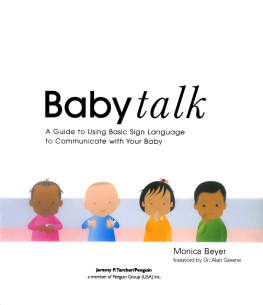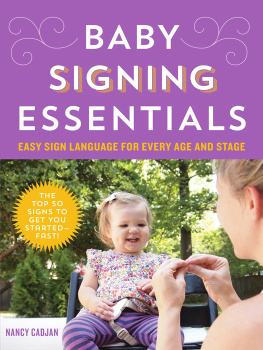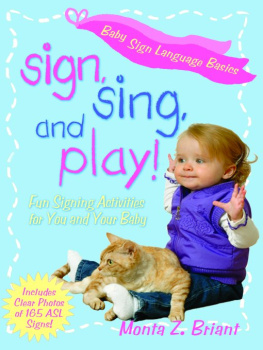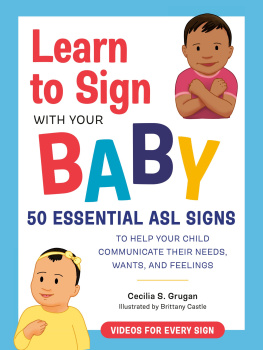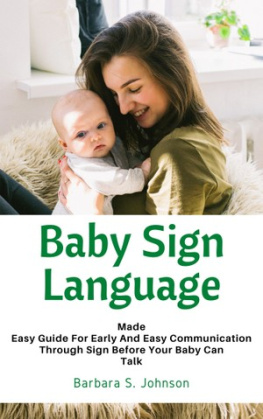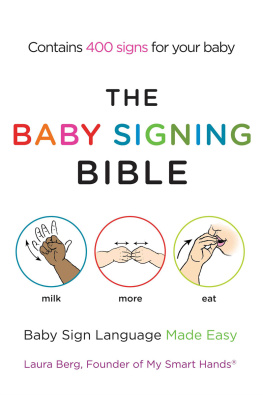Dedication
This book is dedicated to my Nanfor the joy and inspiration she has given to me and everyone who has had the pleasure of knowing her.
I love you Nan.
Introduction
Teach
Your Baby
to Sign!

Why Sign?
W elcome to the wonderful world of signing with babies. I am sharing this world with you, from one parent to another, because of the fun that I have had as a signing mom. I signed with two of my children (Corbin and Lauren) but not with the firstsimply because I didnt know about signing when Dagan was small (oh, but how I wish I had).
In 2000, when Corbin was eleven months old, I was watching a news program that featured a baby girl who used sign language to show her mom that she was in pain because of teething and wanted medicine. I was intrigued and quickly went to the Internet to see what I could find out.
I bought a book online about baby sign language and was very excited to give it a try. Corbin, after about four weeks of my signing milk to him when he nursed, began signing back to me. I was over the moon. We continued our signing, adding more vocabulary, and he became a proficient signer.
I was so inspired by my success with my own baby that I wanted to share what I had learned with other parents, and so I created my own Web site, www.signingbaby.com, in 2000.
Signing is one of the most interesting, fun, exciting, and useful things you can do as a parent. It provides you with amazing insight into your babys world. When I was changing Laurens diaper one day, for example, she began signing dog instead of signing change as she often did. I wasnt sure what she was trying to communicate at first, but her gesture became more pronounced and she indicated, by pointing, the other side of the room. I looked over and realized that she wanted to hold her stuffed dog. If she hadnt known the sign for dog I never would have realized exactly what she was talking about!
Sign language, in addition, encourages the following:
Early Communication
Vocabulary
Speech
Trust
Interaction
Signing has many benefits. For instance, your child will not only be able to tell you when he is hungry, cold, or suffering from an earache, but when he sees a bird in a tree or needs help getting his favorite toy from a shelf. Signing helped my children feel that they could come to me with their ideas, needs, and wants, and they knew that I would more than likely be able to understand and help themall without saying a word.
One day, Corbin was playing with a variety of toys on the floor and he came across a container that held his favorite blocks. He was unable to pry the lid off, but instead of fussing or crying he turned to me and signed help. Signing not only helped him accomplish a physical taskwith assistance from momit allowed him to continue playing without interruption or, more importantly, without getting upset and possibly spiraling into a meltdown from frustration.
The gift of signing helps your baby communicate well before she has the verbal ability to do so. This can make a years worth of difference, or maybe even more a wonderful head start in understanding your babys wants, needs, and interests.
Signing can be helpful well into the toddler years. When children begin speaking, they typically learn a few words at a time, experiencing significant gaps between what they can say and what they would like to say. Signing readily fills these gaps; watch a child simultaneously sign and speak a sentence and youll see how. Communicating in sign language can help toddlers overcome a lot of the frustration that can accompany a need to communicate without the physical ability to do so yet.
This book will not only show you the steps needed to make signing successful in your home, but it also features 200 signs as well as helpful tips for teaching them and incorporating them into your daily life.
Using American Sign Language
This book teaches 200 signs that are from an actual signed languageAmerican Sign Language, otherwise known as ASL.
Why I Chose ASL
I have chosen to useand teach youASL signs for many reasons. One is that it encourages communication with deaf peoplean entire segment of society that we werent able to communicate with at all at one time. Two, its beneficial within your own family. If you have a baby and one or more older children, the older kids will see you signing and learn too, which can help them communicate with a younger sibling.
Signing also helps children learn that there is more to communication than just speech. It teaches them that hand gestures, body movements, and facial expressions can also serve as communication tools, even when not accompanied by spoken words. Knowing this, children and adults may have more success understanding those who dont speak the same language and may be able to communicate more effectively in general as they get older. Teaching children sign language allows them to be comfortable using physical gestures from an early age.
There are many materials out in the marketplace that can help you learn signs to teach to your baby. Most of these products are ASL-based, mainly for consistency reasons. You wouldnt want to show your child a DVD with signs that are not the same as the ones you have learned from a book or online! How confusing would that be?
You might run into a problem where your DVD shows you one sign and this book (or another book) shows you a different one. This is because signs vary from place to place, even within the same country, much like a spoken language. For example, you could order a sub, a hoagie, or a grinder, and still get the same thing. In this case, choose a specific sign that your baby will see most often, so if a particular signing DVD is her absolute favorite, you might use the signs in it if they differ in any way from another reference you are using.
A Brief History of Baby Signing
The baby signing movement officially began in the early 1980s with the ground-breaking research of Dr. Linda Acredolo and Dr. Susan Goodwyn. They began conducting academic research on the subject and eventually published the first baby signing book in 1996, which led to a movement that has gained momentum ever since. Their first book focused on creating your own baby signs, but the second edition incorporated more ASL than its predecessor.
In the 1970s, another pioneer, Dr. Joseph Garcia, began noticing communication and interaction between deaf parents and their hearing babies and the ease with which the babies picked up sign language from their parents. A decade later, he began doing his own research with hearing babies of hearing parents and was inspired and astounded by what he witnessed. His first book, Toddler Talk: The First Signs of Intelligent Life, was published in 1994. A subsequent book, Sign with your Baby, came out in 1999; this was actually the book from which I learned how to sign with my first signing baby.
As I mentioned before, I first heard about signing with babies in 2000, and even then it wasnt a widely known activity. I received a lot of strange looks and even criticism from many people, but persevered. Even though I had no personal experience with baby signing, I thought the idea made a lot of sense and believed that it would happen. Once Corbin started signing back and I realized how sign language allowed him to communicate specific ideas with me, I was hooked. Corbin amazed everyone by his signing abilities as he learned more vocabulary signs. By the time Lauren was born in 2002, signing for babies had become more popular, in part because many childcare providers were beginning to incorporate signing into their daily routines.
Next page

